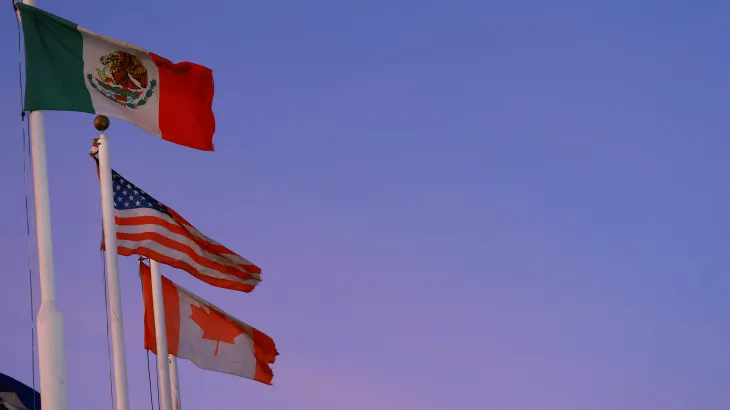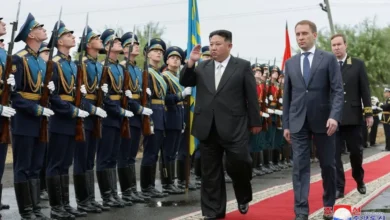Trump tariffs live: US says ‘pain’ worth it as Canada, Mexico hit back

- Canadian Prime Minister Justin Trudeau and Mexican President Claudia Sheinbaum have held a call to discuss strengthening ties and economic cooperation in the face of Trump’s tariff move, which has drawn global condemnation.
- The Trump administration plans to impose levies of 25 percent on goods from Canada, and 10 percent on energy products from the country starting from Tuesday. Goods from Mexico will be subject to tariffs of 25 percent, while imports from China face 10 percent.
What goods come from Mexico to US?
- Of the $480bn in goods imported by the US from Mexico last year, $130bn was made up of vehicles and vehicle parts, according to UN Comtrade data.
- Nearly half of fruit and nut imports, and 63 percent of vegetable imports to the US came from Mexico, according to the US Department of Agriculture.
- The US imported $4.6bn of tequila and mezcal from Mexico in 2023.
Mexico leader denounces US allegation of drug cartel ties
Mexican President Claudia Sheinbaum angrily rejected an accusation by US President Donald Trump’s administration that her government has an alliance with drug cartels.
She hit back at Washington’s accusation her government has an “intolerable alliance” with drug trafficking groups.
“We categorically reject the slander made by the White House against the Mexican government about alliances with criminal organizations,” Sheinbaum wrote.
She also noted a “Plan B” is ready to roll out in response to Trump’s tariffs.
Who pays for tariffs on imports?
President Trump is using tariffs to incentivise Americans to purchase US-made goods. A tariff is a tax applied when a good or service is imported from abroad. It is the “importer of record” – the companies responsible for importing that product – that pay tariffs to governments.
In the US, most importers of record are enrolled onto the government’s electronic payment programme, and have tariff fees automatically deducted when they import products from other countries. In turn, many US companies have expressed frustration with Trump’s frequent assertions that foreign countries pay for tariffs.
So, who ultimately bears the cost of tariffs? There are three potential options:
- Importers absorb the cost, which would eat into company profit margins and could force some firms out of business.
- Importers can coerce the supplier of the good or service to lower their price. If an importer is a big and powerful buyer, it might be able to force its suppliers to eat the cost, but if it’s a small business it likely cannot.
- The tariff cost is passed onto customers in the form of higher prices.
Trump not the first: What was the Smoot-Hawley tariff act?
President Trump’s tariff plan has been compared to another American leader. Within months of the US stock market crash in 1929, US President Herbert Hoover signed the Smoot-Hawley Tariff Act in June 1930.
The measure was initially aimed at protecting US farmers from foreign competition, but eventually extended to a wide range of manufactured goods. It increased tariff rates by 20 percent on average.
In response, other countries imposed retaliatory tariffs on US exports and world trade plummeted. Before signing it into law, more than 1,000 economists sent a letter to President Hoover protesting the bill.
Canada envoy ‘hopeful’ US tariffs don’t take effect on Tuesday
Kristen Hillman, Canada’s ambassador to the US, says she’s hopeful President Trump will negotiate instead of implementing tariffs against her country on Tuesday as threatened.
“Obviously this is disrupting an incredibly successful trading relationship that was just renewed by President Trump in his last term. We renegotiated the NAFTA and brought our trade between our two countries to 99 percent tariff free,” said Hillman.
Former Mexican ambassador warns of US distrust and security implications
Beyond the tariffs, academics and diplomats in Mexico harshly criticised the “retaliation clause” Trump included that threatened to raise tariff levels even higher if the targets hit back.
Martha Barcena, former Mexico ambassador to the US during Trump’s first term, said it’s “very delicate because there has never been such a harsh official statement by the United States government against the Mexican government”.
“It indicates not only a lack of trust, but the consideration of the Mexican government as a national security threat to the United States with all of its implications,” said Barcena.
What do the tariffs mean for Canada?
Economists and other experts have been clear that 25-percent tariffs would hit Canada hard.
Michael Davenport, an economist at Oxford Economics, said in a late November report that blanket 25-percent US tariffs, combined with proportional retaliatory measures by the Canadian government, would push Canada into a recession in 2025.
Canadian exports would drop and the country’s gross domestic product would fall 2.5 percent by early 2026, Davenport said. Inflation would reach 7.2 percent by the middle of next year and 150,000 layoffs would push the unemployment rate to 7.9 percent by the end of 2025.










